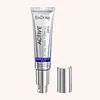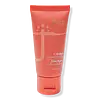What's inside
What's inside
 Key Ingredients
Key Ingredients

 Benefits
Benefits

 Concerns
Concerns

 Ingredients Side-by-side
Ingredients Side-by-side

Water
Skin ConditioningDimethicone
EmollientPolymethyl Methacrylate
Polymethylsilsesquioxane
Methyl Trimethicone
Skin ConditioningPEG-10 Dimethicone
Skin ConditioningGlycerin
HumectantButylene Glycol
HumectantAcrylates/Dimethicone Copolymer
Skin ConditioningSodium Potassium Aluminum Silicate
PEG/PPG-18/18 Dimethicone
EmulsifyingSodium Chloride
MaskingTrimethylsiloxysilicate
EmollientCaprylyl Dimethicone Ethoxy Glucoside
EmulsifyingDisteardimonium Hectorite
StabilisingTriethyl Citrate
MaskingDimethicone Crosspolymer
Emulsion StabilisingSilica
AbrasiveAluminum Hydroxide
EmollientTriethoxycaprylylsilane
Tocopheryl Acetate
AntioxidantDisodium EDTA
Bacillus/Soybean Ferment Extract
Skin ConditioningPhenoxyethanol
PreservativeSodium Dehydroacetate
PreservativePotassium Sorbate
PreservativeCI 77491
Cosmetic ColorantCI 77492
Cosmetic ColorantCI 77499
Cosmetic ColorantCI 77891
Cosmetic ColorantWater, Dimethicone, Polymethyl Methacrylate, Polymethylsilsesquioxane, Methyl Trimethicone, PEG-10 Dimethicone, Glycerin, Butylene Glycol, Acrylates/Dimethicone Copolymer, Sodium Potassium Aluminum Silicate, PEG/PPG-18/18 Dimethicone, Sodium Chloride, Trimethylsiloxysilicate, Caprylyl Dimethicone Ethoxy Glucoside, Disteardimonium Hectorite, Triethyl Citrate, Dimethicone Crosspolymer, Silica, Aluminum Hydroxide, Triethoxycaprylylsilane, Tocopheryl Acetate, Disodium EDTA, Bacillus/Soybean Ferment Extract, Phenoxyethanol, Sodium Dehydroacetate, Potassium Sorbate, CI 77491, CI 77492, CI 77499, CI 77891
Water
Skin ConditioningDimethicone
EmollientIsododecane
EmollientMethyl Trimethicone
Skin ConditioningButylene Glycol
HumectantPEG-9 Polydimethylsiloxyethyl Dimethicone
EmulsifyingPEG-10 Dimethicone
Skin ConditioningVinyl Dimethicone/Methicone Silsesquioxane Crosspolymer
Disteardimonium Hectorite
StabilisingNylon-12
Trimethylsiloxysilicate
EmollientSodium Chloride
MaskingDimethicone/PEG-10/15 Crosspolymer
Triethyl Citrate
MaskingDimethicone/Phenyl Vinyl Dimethicone Crosspolymer
Methicone
EmollientPolysilicone-11
Diglycerin
HumectantTalc
AbrasiveDipropylene Glycol
HumectantMalus Domestica Fruit Cell Culture Extract
Skin ConditioningSodium Citrate
BufferingEnantia Chlorantha Bark Extract
Skin ConditioningXanthan Gum
EmulsifyingTocopherol
AntioxidantMaltodextrin
AbsorbentOrthosiphon Stamineus Extract
Skin ConditioningGlycerin
HumectantLecithin
EmollientOleanolic Acid
Skin ConditioningSodium Dehydroacetate
PreservativePotassium Sorbate
PreservativePhenoxyethanol
PreservativeIron Oxides
Titanium Dioxide
Cosmetic ColorantMica
Cosmetic ColorantWater, Dimethicone, Isododecane, Methyl Trimethicone, Butylene Glycol, PEG-9 Polydimethylsiloxyethyl Dimethicone, PEG-10 Dimethicone, Vinyl Dimethicone/Methicone Silsesquioxane Crosspolymer, Disteardimonium Hectorite, Nylon-12, Trimethylsiloxysilicate, Sodium Chloride, Dimethicone/PEG-10/15 Crosspolymer, Triethyl Citrate, Dimethicone/Phenyl Vinyl Dimethicone Crosspolymer, Methicone, Polysilicone-11, Diglycerin, Talc, Dipropylene Glycol, Malus Domestica Fruit Cell Culture Extract, Sodium Citrate, Enantia Chlorantha Bark Extract, Xanthan Gum, Tocopherol, Maltodextrin, Orthosiphon Stamineus Extract, Glycerin, Lecithin, Oleanolic Acid, Sodium Dehydroacetate, Potassium Sorbate, Phenoxyethanol, Iron Oxides, Titanium Dioxide, Mica
Ingredients Explained
These ingredients are found in both products.
Ingredients higher up in an ingredient list are typically present in a larger amount.
Butylene Glycol (or BG) is used within cosmetic products for a few different reasons:
Overall, Butylene Glycol is a safe and well-rounded ingredient that works well with other ingredients.
Though this ingredient works well with most skin types, some people with sensitive skin may experience a reaction such as allergic rashes, closed comedones, or itchiness.
Learn more about Butylene GlycolDimethicone is a type of synthetic silicone created from natural materials such as quartz.
What it does:
Dimethicone comes in different viscosities:
Depending on the viscosity, dimethicone has different properties.
Ingredients lists don't always show which type is used, so we recommend reaching out to the brand if you have questions about the viscosity.
This ingredient is unlikely to cause irritation because it does not get absorbed into skin. However, people with silicone allergies should be careful about using this ingredient.
Note: Dimethicone may contribute to pilling. This is because it is not oil or water soluble, so pilling may occur when layered with products. When mixed with heavy oils in a formula, the outcome is also quite greasy.
Learn more about DimethiconeDisteardimonium Hectorite comes from the clay mineral named hectorite. It is used to add thickness to a product.
It can also help stabilize a product by helping to disperse other ingredients.
Hectorite is a rare, white clay mineral.
Learn more about Disteardimonium HectoriteGlycerin is already naturally found in your skin. It helps moisturize and protect your skin.
A study from 2016 found glycerin to be more effective as a humectant than AHAs and hyaluronic acid.
As a humectant, it helps the skin stay hydrated by pulling moisture to your skin. The low molecular weight of glycerin allows it to pull moisture into the deeper layers of your skin.
Hydrated skin improves your skin barrier; Your skin barrier helps protect against irritants and bacteria.
Glycerin has also been found to have antimicrobial and antiviral properties. Due to these properties, glycerin is often used in wound and burn treatments.
In cosmetics, glycerin is usually derived from plants such as soybean or palm. However, it can also be sourced from animals, such as tallow or animal fat.
This ingredient is organic, colorless, odorless, and non-toxic.
Glycerin is the name for this ingredient in American English. British English uses Glycerol/Glycerine.
Learn more about GlycerinMethyl Trimethicone is a type of silicone. It is a solvent and emulsifier.
Solvents are used to keep ingredients together in a product. They can help dissolve ingredients to stable bases or help evenly distribute ingredients throughout the product.
Emulsifiers help stabilize a product. It does this by preventing certain ingredients from separating.
Methyl Trimethicone does not get absorbed into the skin.
Learn more about Methyl TrimethiconePeg-10 Dimethicone is silicone with conditioner and emulsifier properties. It mostly acts as an emollient in skincare and and humectant in haircare.
According to the manufacturer, acidic formulations decrease the stability of this ingredient. It works best in neutral or near neutral formulations.
Phenoxyethanol is a preservative that has germicide, antimicrobial, and aromatic properties. Studies show that phenoxyethanol can prevent microbial growth. By itself, it has a scent that is similar to that of a rose.
It's often used in formulations along with Caprylyl Glycol to preserve the shelf life of products.
Potassium Sorbate is a preservative used to prevent yeast and mold in products. It is commonly found in both cosmetic and food products.
This ingredient comes from potassium salt derived from sorbic acid. Sorbic acid is a natural antibiotic and effective against fungus.
Both potassium sorbate and sorbic acid can be found in baked goods, cheeses, dried meats, dried fruit, ice cream, pickles, wine, yogurt, and more.
You'll often find this ingredient used with other preservatives.
Learn more about Potassium SorbateChances are, you eat sodium chloride every day. Sodium Chloride is also known as table salt.
This ingredient has many purposes in skincare: thickener, emulsifier, and exfoliator.
You'll most likely find this ingredient in cleansers where it is used to create a gel-like texture. As an emulsifier, it also prevents ingredients from separating.
There is much debate on whether this ingredient is comedogenic. The short answer - comedogenic ratings don't tell the whole story. Learn more about comegodenic ratings here.
The concensus about this ingredient causing acne seems to be divided. Research is needed to understand if this ingredient does cause acne.
Scrubs may use salt as the primary exfoliating ingredient.
Learn more about Sodium ChlorideThis ingredient is a preservative with antimicrobial properties. It is the sodium salt of dehydroacetic acid.
It is especially effective at preventing bacterial and fungal growth in low concentrations.
Triethyl Citrate comes from citric acid. It has masking, perfuming, and solvent properties. As a solvent, this ingredient helps disperse ingredients evenly in skincare.
One manufacturer claims this ingredient can:
According to perfume manufacturers, this ingredient is almost odorless but has a mild fruity, wine and plum scent. It can be used to mask the scent of other ingredients.
This ingredient can be plant-sourced or synthetic; it can naturally be found in cabbage and white wine.
Learn more about Triethyl CitrateThis silicone is an emollient. Emollients create a thin film on the skin to prevent moisture from escaping.
It is not soluble in water and helps increase water-resistance in products.
According to a manufacturer, it can blend seamlessly with silicone oils, such as Cyclopentasiloxane.
Learn more about TrimethylsiloxysilicateWater. It's the most common cosmetic ingredient of all. You'll usually see it at the top of ingredient lists, meaning that it makes up the largest part of the product.
So why is it so popular? Water most often acts as a solvent - this means that it helps dissolve other ingredients into the formulation.
You'll also recognize water as that liquid we all need to stay alive. If you see this, drink a glass of water. Stay hydrated!
Learn more about Water